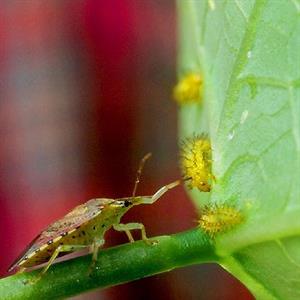A new report from the Izaak Walton League of America highlights the benefits for our natural resources – and American taxpayers – of better leveraging conservation funding to promote five conservation practices now in use on less than one-third of America’s farms and ranches.
As Congress completes a new Farm Bill, the U.S. Department of Agriculture (USDA) and other agencies implement conservation programs, and state and local governments work to fix natural resource problems, focusing funding and programs on practices that deliver benefits for more than one natural resource can provide more conservation “bang” for our taxpayer “bucks.”
 Our new report, “Leveraging Conservation Dollars: Agricultural Practices that Deliver Water Quality, Wildlife Habitat, and Soil Health,” describes the benefits of five practices in growing use on America’s farms and ranches: no till, buffer strips, cover crops, integrated pest management (IPM), and managed rotational grazing.
Our new report, “Leveraging Conservation Dollars: Agricultural Practices that Deliver Water Quality, Wildlife Habitat, and Soil Health,” describes the benefits of five practices in growing use on America’s farms and ranches: no till, buffer strips, cover crops, integrated pest management (IPM), and managed rotational grazing.
All five practices are known for the water quality benefits they provide by keeping nitrogen, phosphorus, pesticides, soil, and manure out of our rivers, lakes, and wetlands. In addition, they improve fish and wildlife habitat, soil health, and soil carbon storage that can help mitigate climate change.
Used in combination, these five conservation practices can:
- virtually eliminate runoff of nutrients, pesticides, and manure from farm operations
- improve fish habitat
- provide year-round food and cover for birds, deer, pollinators, and other wildlife
- rapidly regenerate soil health
- store vast amounts of carbon in the soil
They provide all these benefits while also maintaining – and often boosting – farm profits.
Policy Implications
The report has important implications as Congress completes a new Farm Bill, the USDA and other agencies implement conservation programs, and state and local governments work to address natural resource problems linked to our current agricultural production systems.
Congress should maintain Conservation Reserve Program incentive payments for conservation buffers, and should focus more CRP acres on these high-value practices. The new Farm Bill should push USDA to focus more attention on regenerating soil health, and should provide a ‘good farmer discount’ on crop insurance for farmers who adopt practices like those highlighted in the report that build soil health and increase resiliency.
Congress should retain a strong Conservation Stewardship Program (CSP), which helps farmers and ranchers install conservation systems that integrate multiple practices, like Integrated Pest Management. The new Farm Bill should maintain robust funding for CSP and other working lands programs, and should increase funding for the Regional Conservation Partnership Program that combines federal, state, local, and private dollars to tackle regional problems.
USDA should restore incentive payments for conservation buffers under CRP, again allow farmers to enroll in high-value CRP practices on a continuous basis, and maintain full enrollment of CRP acres. USDA should also prioritize conservation systems that deliver multiple resource benefits as it implements programs and awards conservation contracts to farmers. USDA should also launch a nation-wide cover crop initiative to broaden the use of cover crops.
State and local governments should better fund soil health initiatives, and should leverage federal conservation dollars through innovative projects that use the federal Conservation Reserve Enhancement Program and Regional Conservation Partnership Program. States should help every farmer and rancher create and implement a whole-farm conservation plan that addresses the most important natural resource problems in their area.
Delivering Multiple Benefits
About one-third of crop fields are farmed using no till methods, and the other conservation systems highlighted are even less well-used across the country. Yet no till, buffer strips, cover crops, integrated pest management, and managed rotational grazing provide huge benefits for our natural resources. Once in place, these conservation systems often boost farm profits by improving soil health and reducing the need for expensive fertilizers, pesticides, fuel, and other inputs.
The report brings together recent science that identifies the impact of no till, buffer strips, cover crops, Integrated Pest Management, and managed rotational grazing on water quality, fish and wildlife habitat, soil health, and carbon storage.
All five conservation systems are used to address water quality problems, and they have been proven to reduce runoff of nitrogen, phosphorus, pesticides, and other pollutants from agricultural land into nearby streams and wetlands. When these conservation systems are used in combination, they can sharply reduce or even eliminate polluted runoff.
Improving water quality will benefit fish, but these five conservation systems also deliver benefits for wildlife on land. No till and cover crops provide food and shelter over winter and well into spring for a host of birds, deer, and other critters. Buffer strips and rotationally grazed pastures provide permanent habitat for grassland birds and other wildlife. Integrated pest management can reduce or eliminate the unintended impacts of pesticides on pollinators, birds, and other wildlife.
All five conservation systems also help conserve and regenerate soil health. No till reduces erosion and protects beneficial fungi in the soil. Cover crops and perennial plants in buffer strips and well-managed pastures protect the soil from erosion, and their roots pump carbohydrates into the soil that feed beneficial fungi and bacteria year-around. IPM reduces or eliminates the use of pesticides that can harm beneficial fungi and bacteria.
As they restore soil health, these practices also boost the organic carbon content in the soil. That stores carbon from the atmosphere in the soil, helping offset the impacts of greenhouse gas emissions that are driving climate change.
By better focusing conservation programs on innovative systems like these five, policy-makers can deliver more conservation benefits for our taxpayer dollars.
You can download a copy of the full report, a summary, and the League’s 10 Steps to Leverage Conservation Dollars on our agriculture web page.